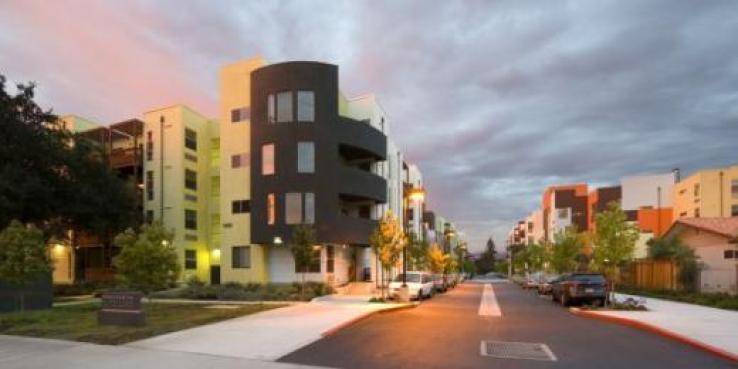In January 2010, San Jose passed an inclusionary housing law to help do three things: address the city’s affordable housing needs, meet the state’s requirement for regional fair share housing and promote economic integration. But now a successful legal suit has thrown the future of this law into question. To understand what’s at stake, this post takes a look at how the 2010 ordinance was designed to work and what the lawsuit could mean for San Jose and other California cities.
Before 2010, San Jose’s inclusionary housing policy applied only to redevelopment areas, but the 2010 ordinance expanded the requirements citywide. The ordinance applies to residential developments of 20 units or more and requires that 15 percent of units in for-sale housing developments be made available for purchase by income-restricted households at below market rates. Additionally, 9 percent of the dwelling units in rental developments must be priced for moderate-income households and 6 percent for very low income households. (“Moderate income” is defined as $53,000 for a 1-person household and $75,700 for a 4-person household, and “very low income” is $36,750 for a 1-person household and $52,500 for a 4-person household.)
The ordinance creates an incentive for developers to build the inclusionary units on-site, but it also provides them with other options to fulfill their affordable housing obligations. For example, developers can pay an in-lieu fee that helps to fund future affordable housing initiatives in the city, build affordable units at a separate location or dedicate land for future affordable housing developments. Additionally, the ordinance places deed restrictions to ensure that the inclusionary units remain affordable well into the future. In the event that an owner of an inclusionary unit were to sell the home to a buyer who does not meet the income requirements, the city would capture a portion of the appreciated value of the home. Those proceeds, similar to the developer in-lieu fee, would pay for future affordable housing.
The ordinance is meant to help San Jose reach its housing goal of providing more than 19,000 affordable housing units between 2007 and 2014, as determined by the Association of Bay Area Governments and in accordance with the state-required regional housing needs allocation (RHNA) process. The city had already implemented precedents for this concept in large-scale development plans, including the redevelopment of the former Hitachi industrial campus and North San Jose’s Specific Plan, where a portion of the new homes built would be affordable as a way of ensuring a diverse community.
San Jose’s inclusionary housing ordinance was slated to go into effect in January 2013, but following its adoption the California Building Industry Association (CBIA), with assistance from the BIA Bay Area, filed a lawsuit to overturn it. The plaintiffs argued that the city did not show proof that market rate housing adversely affected the community or created the need for affordable housing. Proving evidence of a relationship between the impacts of a development and the requirements put on the developer, called a “nexus,” has been established as a constitutional standard in previous land use lawsuits. In certain cases cities will undertake a nexus study to prove the relationship before proposing fees or requirements. However, it is very unusual for jurisdictions to do nexus studies to justify their inclusionary housing ordinances. Normally, cities can rely on the “police powers” afforded them under state and federal law in order to enact inclusionary housing laws for the purposes of regulating land use or protecting the health and well-being of their citizens. This is nothing new in California cities: The California Coalition for Rural Housing compiled a database that indexes 145 inclusionary policies in different jurisdictions statewide, nearly half of which are enacted in other Bay Area cities.
In May 2012, the lawsuit against San Jose’s inclusionary housing ordinance prevailed and Santa Clara County Superior Court overturned it. San Jose is in the process of appealing this decision, and the outcome could have implications for any California city that passed similar measures without a nexus study.
Until the appeal is heard, no part of the law can be enforced, and San Jose cannot rely on its inclusionary ordinance to provide affordable housing. Meanwhile, it and other California cities can no longer rely on redevelopment funding that came from tax increment financing, 20 percent of which (and in San Jose’s case, up to 40 percent) was used to fund affordable housing. Since 1988, these funds have helped finance 175 developments in San Jose, providing 13,920 affordable units. The economic meltdown, coupled with these cuts to funding, has left the city significantly behind in meeting its RHNA goals for the 2007-2014 period. (These goals are mandated by state housing law as a way to quantify the need for housing within each city during specific planning periods,) And there is no new source of funds on the horizon.
Meanwhile, the need for housing that is affordable to the local workforce, across the spectrum of incomes in San Jose, remains as high as ever. Affordable housing developers are still trying to pursue projects in San Jose, and the city’s housing department plans on continuing to support affordable housing. Their goal is to provide funding for affordable housing units currently in the pipeline, despite limited funding.
SPUR believes it is important to increase thesupply of housing at all income levels; when designed and located well, housing can become a tool for strengthening neighborhoods and local economies. We also believe that one type of housing need not be built at the expense of another. Instead, we must work collaboratively to obtain the necessary financial resources and regulatory tools to build it all.We hope the city’s inclusionary housing ordinance will be reinstated, and that San Jose will be able to find new resources to help construct badly needed affordable housing.
